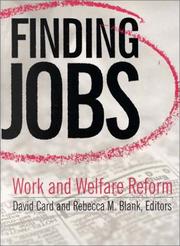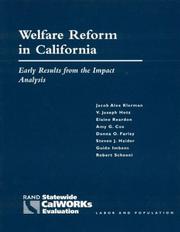| Listing 1 - 10 of 16 | << page >> |
Sort by
|

ISBN: 0880993170 1417596317 9781417596317 9780880993166 0880993162 9780880993173 Year: 2004 Publisher: Kalamazoo, Mich. W.E. Upjohn Institute for Employment Research
Abstract | Keywords | Export | Availability | Bookmark
 Loading...
Loading...Choose an application
- Reference Manager
- EndNote
- RefWorks (Direct export to RefWorks)

ISBN: 0871541165 9780871541161 Year: 2001 Publisher: New York: Russell Sage Foundation,
Abstract | Keywords | Export | Availability | Bookmark
 Loading...
Loading...Choose an application
- Reference Manager
- EndNote
- RefWorks (Direct export to RefWorks)

ISBN: 2130509282 9782130509288 Year: 2000 Publisher: Paris: PUF,
Abstract | Keywords | Export | Availability | Bookmark
 Loading...
Loading...Choose an application
- Reference Manager
- EndNote
- RefWorks (Direct export to RefWorks)
L'assistance sociale a connu récemment une transformation majeure : elle est devenue une aide liée, recouvrant de nouvelles formes de réciprocité et de nouveaux espaces de négociation. Le workfare, aux États-Unis, et l'insertion, en France, traduisent cette évolution. L'analyse comparative présentée ici s'appuie sur un cadre théorique qui dégage deux logiques de la réciprocité.
Public welfare --- Welfare recipients --- Social integration --- Aide sociale --- Intégration sociale --- Employment --- Bénéficiaires --- Travail --- France --- United States --- Etats-Unis --- Social policy --- Politique sociale --- Exclusion sociale --- Service social --- Sécurité économique --- Études comparatives --- États-Unis --- Intégration sociale --- Bénéficiaires --- Études comparatives. --- Exclusion sociale. --- Sécurité économique. --- Welfare recipients - Employment - United States --- Welfare recipients - Employment - France --- United States - Social policy --- France - Social policy
Book
ISBN: 9780199237418 0199237417 Year: 2008 Publisher: Oxford: Oxford university press,
Abstract | Keywords | Export | Availability | Bookmark
 Loading...
Loading...Choose an application
- Reference Manager
- EndNote
- RefWorks (Direct export to RefWorks)
Welfare recipients --- Public welfare --- Aide sociale --- Employment --- Law and legislation --- Bénéficiaires --- Travail --- Droit --- Legal status, laws, etc --- Bénéficiaires --- Welfare recipients - Employment - Law and legislation - Great Britain --- Welfare recipients - Employment - Law and legislation - United States --- Welfare recipients - Legal status, laws, etc - Great Britain --- Welfare recipients - Legal status, laws, etc - United States --- Public welfare - Great Britain --- Public welfare - United States

ISBN: 0833035967 0833030396 9780833035967 9780833030399 Year: 2003 Publisher: RAND Corporation
Abstract | Keywords | Export | Availability | Bookmark
 Loading...
Loading...Choose an application
- Reference Manager
- EndNote
- RefWorks (Direct export to RefWorks)
Examines the effects of the California Work Opportunity and Responsibility to Kids (CalWORKs) program on work activity participation rates of welfare recipients, welfare caseloads, and outcomes for welfare leavers. While the CalWORKs reforms appear to have been responsible for some of the uniform improvement in outcomes shown by the analysis, the robust economy and other policy changes were probably also important.
California Work Opportunity and Responsibility to Kids (Program). --- Public welfare--California. --- Welfare recipients--Employment--California. --- Welfare recipients --- Public welfare --- Social Welfare & Social Work - General --- Social Welfare & Social Work --- Social Sciences --- Employment --- California Work Opportunity and Responsibility to Kids (Program) --- CalWORKS

ISBN: 0585245517 9780585245515 0585235082 9780585235080 9780833027207 0833027204 0833027190 9780833027191 0833027204 9780833043375 0833043374 Year: 1999 Publisher: Santa Monica, CA Rand
Abstract | Keywords | Export | Availability | Bookmark
 Loading...
Loading...Choose an application
- Reference Manager
- EndNote
- RefWorks (Direct export to RefWorks)
Welfare recipients --- Public welfare --- Social Welfare & Social Work - General --- Social Welfare & Social Work --- Social Sciences --- Employment --- California Work Opportunity and Responsibility to Kids (Program). --- Public welfare -- California. --- Welfare recipients -- Employment -- California. --- California Work Opportunity and Responsibility to Kids (Program)
Book
ISBN: 1598751077 9781598751079 Year: 2002 Publisher: Santa Monica : RAND Corporation,
Abstract | Keywords | Export | Availability | Bookmark
 Loading...
Loading...Choose an application
- Reference Manager
- EndNote
- RefWorks (Direct export to RefWorks)
Responding to new funding, the Los Angeles County Board of Supervisors adopted a Long-Term Family Self-Sufficiency (LTFSS) plan in November 1999. This work summarizes the plan, and describes outcomes and indicators used to measure progress.
Public welfare. --- Public welfare - California - Los Angeles County. --- Welfare recipients. --- Welfare recipients - Employment - California - Los Angeles County. --- Welfare recipients --- Public welfare --- Employment --- Long-Term Family Self-Sufficiency Plan (Los Angeles County, Calif.) --- California Work Opportunity and Responsibility to Kids (Program)

ISBN: 0585247706 9780585247700 0833027220 9780833027221 0833027239 9780833027238 9780833027641 0833027646 0833043382 9780833043382 Year: 1999 Publisher: Santa Monica, CA Rand
Abstract | Keywords | Export | Availability | Bookmark
 Loading...
Loading...Choose an application
- Reference Manager
- EndNote
- RefWorks (Direct export to RefWorks)
Social Welfare & Social Work - General --- Social Welfare & Social Work --- Social Sciences --- California Work Opportunity and Responsibility to Kids (Program). --- Evaluation research (Social action programs) -- California. --- Public welfare -- California. --- Welfare recipients -- Employment -- California. --- Welfare recipients --- Public welfare --- Evaluation research (Social action programs) --- Employment --- California Work Opportunity and Responsibility to Kids (Program)
Multi
ISSN: 13760955 ISBN: 9782875742322 9783035264951 2875742329 Year: 2014 Volume: 79 Publisher: Brussels: P.I.E. Peter Lang,
Abstract | Keywords | Export | Availability | Bookmark
 Loading...
Loading...Choose an application
- Reference Manager
- EndNote
- RefWorks (Direct export to RefWorks)
Since the 1990s and the 2000s, Western social protection systems have experienced a turn towards activation. This turn consists of the multiplication of measures aimed at bringing those who are unemployed closer to participation in the labour market. These measures often induce a strengthening of the conditions that must be met in order to receive social benefits. It is in this well known context that the authors gathered in this book decided to take a closer look at the relationship between activation policies for the unemployed and the right and the duty to work. If activation measures are likely to increase transitions towards the labour market, we can also make the assumption that they may, particularly when they are marked with the seal of coercion, hinder or dramatically reduce the right to freely chosen work. In such circumstances, the realisation of the «right to work», which is often stated to be the aim of those who promote activation, tends in practice to be reduced to an increasing pressure being exerted on the unemployed. In this case, isn’t it actually the duty to work that is particularly reinforced ? After an historical and philosophical perspective on the issue, this assumption is confronted with the developments observed in the United States and in France, and then with the guidelines laid down in international human rights instruments. What follows is a discussion of two alternatives to the dominant activation model : the basic income guarantee and the employment guarantee
Labour market --- Social law. Labour law --- Labor market --- Unemployed --- Labor policy --- Right to labor --- Marché du travail --- Chômeurs --- Travail --- Droit au travail --- Legal status, laws, etc. --- Droit --- Politique gouvernementale --- Welfare recipients --- Employment --- Government policy --- Marché de l'emploi --- Chômage --- Politique du travail --- Services aux --- Politique publique --- Marché du travail --- Chômeurs --- Labor --- Congresses --- Services for --- Marché du travail. --- Politique du travail. --- Droit au travail. --- Services aux. --- Politique publique. --- Welfare recipients - Employment --- Unemployed - Government policy --- France --- Etats-Unis
Book
ISBN: 2760513653 9782760513655 9781435685093 1435685091 9782760518544 276051854X Year: 2005 Volume: 17 Publisher: Sainte-Foy (Québec): Presses de l'Université,
Abstract | Keywords | Export | Availability | Bookmark
 Loading...
Loading...Choose an application
- Reference Manager
- EndNote
- RefWorks (Direct export to RefWorks)
Cet ouvrage définit la notion de revenu minimum garanti avant d'explorer les diverses modalités (minimum social, impôt négatif et revenu de citoyenneté) au Canada, aux États-Unis et dans divers pays européens. L'auteur fait ressortir les dilemmes que pose toute stratégie de mise en place d'un revenu minimum garanti tant au plan des effets redistributifs et de l'efficacité économique qu'à celui de l'incitation à l'emploi et aborde aussi les controverses quant à sa faisabilité économique et sa légitimité politique.
Guaranteed annual income. --- Social security. --- Poverty --- Welfare recipients --- Income distribution. --- Government policy. --- Employment. --- Workfare --- Insurance, Social --- Insurance, State and compulsory --- Social insurance --- Insurance --- Income maintenance programs --- Destitution --- Wealth --- Basic needs --- Begging --- Poor --- Subsistence economy --- Distribution of income --- Income inequality --- Inequality of income --- Distribution (Economic theory) --- Disposable income --- Annual income guarantee --- Basic income guarantee --- Guaranteed annual income --- Guaranteed income --- Guaranteed minimum income --- Universal basic income --- Economic security --- Income --- Poverty - Government policy. --- Welfare recipients - Employment.
| Listing 1 - 10 of 16 | << page >> |
Sort by
|

 Search
Search Feedback
Feedback About UniCat
About UniCat  Help
Help News
News